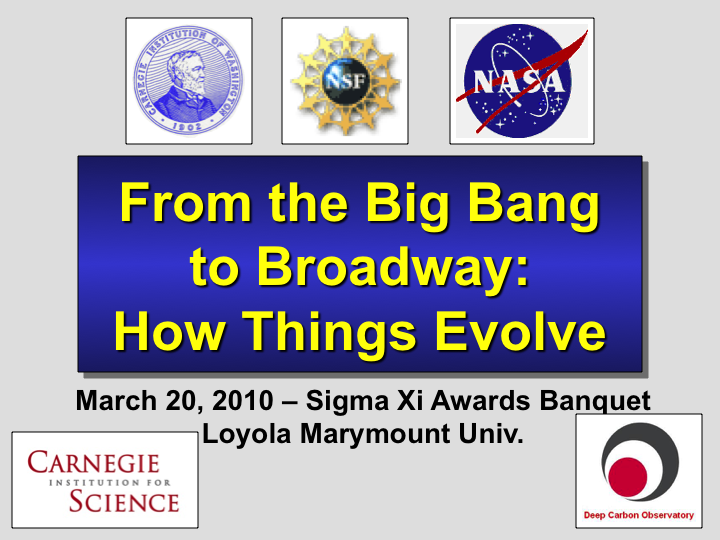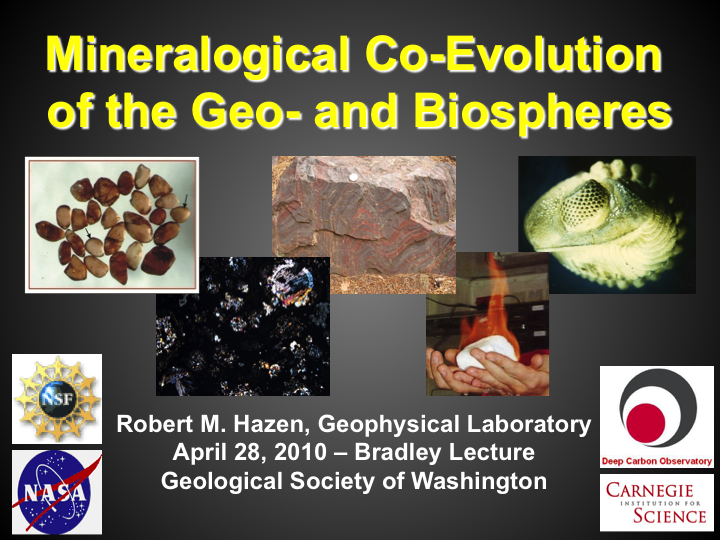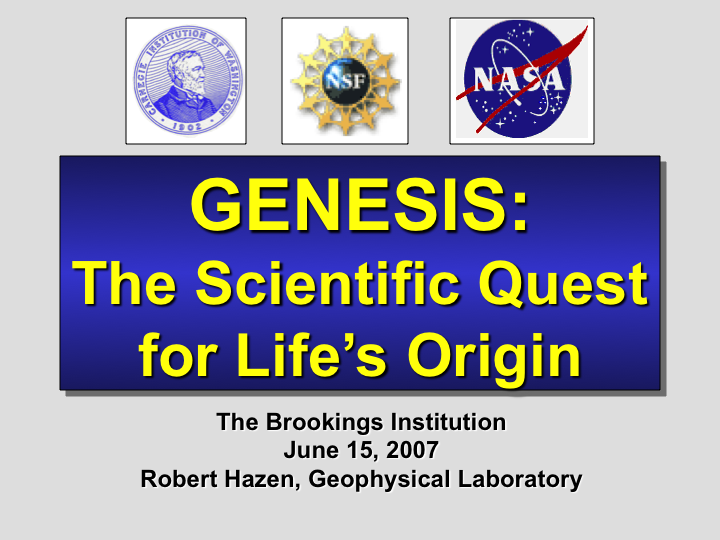Lecture Topics
THE DEEP CARBON OBSERVATORY: UNANSWERED QUESTIONS IN DEEP CARBON SCIENCE
In spite of carbon's importance, many unanswered questions remain regarding the physical, chemical, and biological behavior of carbon-bearing systems at depths greater than a few hundred meters. Recent results from field, experimental and theoretical studies point to the need for a new broadly interdisciplinary effort to understand deep carbon reservoirs and fluxes, the extent of possible deep abiotic organic synthesis, and the nature and extent of the deep biosphere. The Deep Carbon Observatory is an international organization devoted to the study of these unanswered questions [1]. Recent findings underscore the need for a focus on deep carbon science. In particular, experimental discoveries of high-P-T organic synthesis from inorganic precursors [2], observations of complex interactions between organic molecules and minerals [3], field evidence for significant outgassing of C-O-H-N volatiles [4], recognition of extensive deep microbial ecosystems [5], and new experimental measurements and theoretical models of carbon sources and sinks [6] demand a careful reappraisal of deep carbon.
[1] http://deepcarbon.net
[2] Kutcherov et al. (2002) Proc. Russ. Acad. Sci. 387:789; Scott et al. (2004) PNAS 101:14023
[3] Hazen (2006) Am. Mineral. 91:1715
[4] Sohn et al. (2008) Nature 453:1236
[5] Roussel et al. (2008) Science 320:1046
[6] Oganov et al. (2008) EPSL 273:38; Nakajima et al. (2009) PEPI 174:202; Zhang & Duan (2009) GCA 73:2099
FROM THE BIG BANG TO BROADWAY: HOW THINGS EVOLVE

Evolution has long been a lightning rod for anti-science rhetoric. Such attacks are usually reserved for discussions of Darwinian evolution by natural selection, but evolving systems also operate in many other contexts, including the formation of chemical elements in stars following the Big Bang, diversification of minerals on Earth-like planets, development of languages, and more. Although each of these complex systems evolves through selective mechanisms, they fundamentally differ from each other. Comparisons point to general principles of emergent complexity, and underscore the power and plausibility of biological evolution.
Download: [PPT] [PDF] [iTunes lecture number 33]
THEMES AND VARIATIONS IN EVOLVING SYSTEMS
 Evolution, the natural process by which systems under selective pressure become more complex, has long been a lightning rod for anti-science rhetoric. Such attacks are usually reserved for discussions of biological (Darwinian) evolution by natural selection, but complex evolving systems also operate in many other natural and human contexts, including the formation of chemical elements in stars, diversification of minerals on Earth-like planets, prebiotic synthesis of biomolecules, development of languages, and progress in material culture. In each of these complex systems the distribution of species evolves through selective mechanisms, and each system displays such similar characteristics as diversification into niches (radiation), episodic periods of innovation (punctuation), and the loss and replacement of previous species (extinction). However, these systems differ from each other in fundamental respects, notably in the degree to which their species demonstrate mutability, heritability and lateral transfer of traits. Comparisons among these disparate evolving systems point to general principles of emergent complexity, and underscore the power and plausibility of biological evolution.
Evolution, the natural process by which systems under selective pressure become more complex, has long been a lightning rod for anti-science rhetoric. Such attacks are usually reserved for discussions of biological (Darwinian) evolution by natural selection, but complex evolving systems also operate in many other natural and human contexts, including the formation of chemical elements in stars, diversification of minerals on Earth-like planets, prebiotic synthesis of biomolecules, development of languages, and progress in material culture. In each of these complex systems the distribution of species evolves through selective mechanisms, and each system displays such similar characteristics as diversification into niches (radiation), episodic periods of innovation (punctuation), and the loss and replacement of previous species (extinction). However, these systems differ from each other in fundamental respects, notably in the degree to which their species demonstrate mutability, heritability and lateral transfer of traits. Comparisons among these disparate evolving systems point to general principles of emergent complexity, and underscore the power and plausibility of biological evolution.
MINERALOGICAL CO-EVOLUTION OF THE GEOSPHERE AND BIOSPHERE
 The mineralogy of terrestrial planets and moons evolves as a consequence of selective physical, chemical and biological processes (Hazen et al. 2008). Mineral evolution begins with approximately 12 different refractory minerals that form in the cooling envelopes of exploding stars. Subsequent aqueous and thermal alteration of planetessimals results in the approximately 250 minerals now found in unweathered lunar and meteorite samples. Following Earth's accretion and differentiation, mineral evolution resulted from a sequence of geochemical and petrologic processes, which led to perhaps 1500 mineral species. According to some origin-of-life scenarios, a planet must progress through at least some of these stages of chemical processing as a prerequisite for life. Once life emerged, mineralogy and biology co-evolved and dramatically increased Earth's mineral diversity to >4000 species. Sequential stages of mineral evolution arise from three primary mechanisms: (1) the progressive separation and concentration of the elements from their original relatively uniform distribution in the presolar nebula; (2) the increase in range of intensive variables such as pressure, temperature, and volatile activities; and (3) the generation of far-from-equilibrium conditions by living systems. Remote observations of the mineralogy of other terrestrial bodies may thus provide evidence for biological influences beyond Earth. Recent studies of mineral diversification through time reveal striking correlations with major geochemical, tectonic, and biological events, including large-changes in ocean chemistry, the supercontinent cycle, the increase of atmospheric oxygen, and the rise of the terrestrial biosphere.
The mineralogy of terrestrial planets and moons evolves as a consequence of selective physical, chemical and biological processes (Hazen et al. 2008). Mineral evolution begins with approximately 12 different refractory minerals that form in the cooling envelopes of exploding stars. Subsequent aqueous and thermal alteration of planetessimals results in the approximately 250 minerals now found in unweathered lunar and meteorite samples. Following Earth's accretion and differentiation, mineral evolution resulted from a sequence of geochemical and petrologic processes, which led to perhaps 1500 mineral species. According to some origin-of-life scenarios, a planet must progress through at least some of these stages of chemical processing as a prerequisite for life. Once life emerged, mineralogy and biology co-evolved and dramatically increased Earth's mineral diversity to >4000 species. Sequential stages of mineral evolution arise from three primary mechanisms: (1) the progressive separation and concentration of the elements from their original relatively uniform distribution in the presolar nebula; (2) the increase in range of intensive variables such as pressure, temperature, and volatile activities; and (3) the generation of far-from-equilibrium conditions by living systems. Remote observations of the mineralogy of other terrestrial bodies may thus provide evidence for biological influences beyond Earth. Recent studies of mineral diversification through time reveal striking correlations with major geochemical, tectonic, and biological events, including large-changes in ocean chemistry, the supercontinent cycle, the increase of atmospheric oxygen, and the rise of the terrestrial biosphere.
Hazen RM, Papineau D, Bleeker W, Downs RT, Ferry JM, McCoy TJ, Sverjensky DA, Yang H (2008) Mineral evolution. American Mineralogist 93:1693-1720
Download: [PPT] [PDF] [Video Part 1] [Video Part 2] [Video Part 3]
GENESIS: THE SCIENTIFIC QUEST FOR LIFE'S ORIGINS
 Questions about life's origins and evolution are among the most profound and controversial topics in science. To tackle life's origin in the laboratory using the scientific method is a daunting challenge. The new field of emergence -- the study of complex systems that arise through the interaction of many components -- provides a powerful framework for that search. We are surrounded by emergent systems: molecules link to form cells, ants interact to form colonies, and brain cells network to form the conscious mind. In each instance, numerous interacting individual "agent" produce complex systems with new, often delightfully unexpected properties and behaviors. Life's origins can be modeled as a sequence of emergent steps, leading from geochemical simplicity to biochemical complexity.
Questions about life's origins and evolution are among the most profound and controversial topics in science. To tackle life's origin in the laboratory using the scientific method is a daunting challenge. The new field of emergence -- the study of complex systems that arise through the interaction of many components -- provides a powerful framework for that search. We are surrounded by emergent systems: molecules link to form cells, ants interact to form colonies, and brain cells network to form the conscious mind. In each instance, numerous interacting individual "agent" produce complex systems with new, often delightfully unexpected properties and behaviors. Life's origins can be modeled as a sequence of emergent steps, leading from geochemical simplicity to biochemical complexity.
Download: [PPT] [PDF] [Video Part 1] [Video Part 2]
RIGHT AND LEFT: MINERAL SURFACES, MOLECULAR SELECTION, AND THE ORIGIN OF LIFE'S HOMOCHIRALITY
 Life arose on Earth as a geochemical process from the interaction of rocks, water, and gases. Prior to the origin of life, the necessary organic molecules had formed abundantly, but indiscriminately, both in space and on Earth. A major mystery of life's origin is how an idiosyncratic subset of those diverse molecules was selected and concentrated from the prebiotic soup to form more complex structures leading to the development of life. Rocks and minerals are likely to have played several critical roles in this selection, especially as templates for the adsorption and organization of these molecules. Our recent experimental and theoretical studies on interactions between crystals and organic molecules reveal that crystals with chiral surface structures may have facilitated the separation of left- and right-handed biomolecules — the possible origin of life's distinctive homochirality. Application of DNA microarray technology to this problem now facilitates the simultaneous investigation of hundreds of mineral-molecule pairs.
Life arose on Earth as a geochemical process from the interaction of rocks, water, and gases. Prior to the origin of life, the necessary organic molecules had formed abundantly, but indiscriminately, both in space and on Earth. A major mystery of life's origin is how an idiosyncratic subset of those diverse molecules was selected and concentrated from the prebiotic soup to form more complex structures leading to the development of life. Rocks and minerals are likely to have played several critical roles in this selection, especially as templates for the adsorption and organization of these molecules. Our recent experimental and theoretical studies on interactions between crystals and organic molecules reveal that crystals with chiral surface structures may have facilitated the separation of left- and right-handed biomolecules — the possible origin of life's distinctive homochirality. Application of DNA microarray technology to this problem now facilitates the simultaneous investigation of hundreds of mineral-molecule pairs.
MINERAL EVOLUTION OF TERRESTRIAL PLANETS
![]() The mineralogy of terrestrial planets evolves as a consequence of varied physical, chemical and biological processes. Initial evolutionary stages include the transition from ~12 nano-scale mineral phases in pre-stellar dense molecular clouds, to ~60 primary chondrite minerals, to ~250 different minerals in altered chondrites, achondrites and differentiated asteroids. Earth's subsequent prebiotic mineral evolution depended on a sequence of geochemical and petrologic processes, including volcanism and degassing, fractional crystallization, crystal settling, assimilation reactions, regional and contact metamorphism, plate tectonics and associated large-scale fluid-rock interactions. These processes resulted in perhaps 1500 different mineral species. Biological processes began to affect Earth's surface mineralogy by the Eoarchean, when large-scale surface mineral deposits, including carbonates and banded iron formations, were precipitated under the influences of changing atmospheric and ocean chemistry. The Paleoproterozoic "Great Oxidation Event" and Neoproterozoic increases in atmospheric O2 transformed Earth's surface mineralogy and are responsible, directly or indirectly, for most of Earth's 4300 known mineral species. Mineral evolution arises from three primary mechanisms: (1) progressive separation and concentration of elements from their original relatively uniform distribution; (2) an increase in range of intensive variables such as pressure, temperature, and the activities of H2O, CO2 and O2; and (3) generation of far-from-equilibrium conditions by living systems. The sequential evolution of Earth's mineralogy from chondritic simplicity to Phanerozoic complexity introduces the dimension of geologic time to mineralogy and thus provides a dynamic alternate approach to framing the mineral sciences.
The mineralogy of terrestrial planets evolves as a consequence of varied physical, chemical and biological processes. Initial evolutionary stages include the transition from ~12 nano-scale mineral phases in pre-stellar dense molecular clouds, to ~60 primary chondrite minerals, to ~250 different minerals in altered chondrites, achondrites and differentiated asteroids. Earth's subsequent prebiotic mineral evolution depended on a sequence of geochemical and petrologic processes, including volcanism and degassing, fractional crystallization, crystal settling, assimilation reactions, regional and contact metamorphism, plate tectonics and associated large-scale fluid-rock interactions. These processes resulted in perhaps 1500 different mineral species. Biological processes began to affect Earth's surface mineralogy by the Eoarchean, when large-scale surface mineral deposits, including carbonates and banded iron formations, were precipitated under the influences of changing atmospheric and ocean chemistry. The Paleoproterozoic "Great Oxidation Event" and Neoproterozoic increases in atmospheric O2 transformed Earth's surface mineralogy and are responsible, directly or indirectly, for most of Earth's 4300 known mineral species. Mineral evolution arises from three primary mechanisms: (1) progressive separation and concentration of elements from their original relatively uniform distribution; (2) an increase in range of intensive variables such as pressure, temperature, and the activities of H2O, CO2 and O2; and (3) generation of far-from-equilibrium conditions by living systems. The sequential evolution of Earth's mineralogy from chondritic simplicity to Phanerozoic complexity introduces the dimension of geologic time to mineralogy and thus provides a dynamic alternate approach to framing the mineral sciences.
SLOW LIFE: CAN HIGH PRESSURE ENHANCE LONG-TERM SURVIVAL OF MICROORGANISMS?
 Purported instances of long-term bacterial dormancy and survival have been ascribed to a variety of environmental factors, including desiccation, freezing, hypersalinity, or anoxia. Here we outline an experimental approach to investigate whether high pressures on the order of 0.1 to 1.0 GPa (1000 to 10,000 atmospheres) might also promote microbial stasis and longevity in some geochemical environments. Several lines of evidence point to the possible influence of high-pressure environments on long-term microbial survival. Experiments and field observations support the contention that microbes survive in a dormant state under high-pressure conditions. Sharma et al. (2002) documented significantly reduced microbial activity, but sustained viability, in strains of Escherichia coli (MG1655) and Shewanella oneidensis (MR1) at pressures to 1.6 GPa.
Purported instances of long-term bacterial dormancy and survival have been ascribed to a variety of environmental factors, including desiccation, freezing, hypersalinity, or anoxia. Here we outline an experimental approach to investigate whether high pressures on the order of 0.1 to 1.0 GPa (1000 to 10,000 atmospheres) might also promote microbial stasis and longevity in some geochemical environments. Several lines of evidence point to the possible influence of high-pressure environments on long-term microbial survival. Experiments and field observations support the contention that microbes survive in a dormant state under high-pressure conditions. Sharma et al. (2002) documented significantly reduced microbial activity, but sustained viability, in strains of Escherichia coli (MG1655) and Shewanella oneidensis (MR1) at pressures to 1.6 GPa.
EMERGENCE AND THE AMBIGUITY OF WHAT IS ALIVE
The question "What is life?" is complicated by the fact that a continuum may exist between chemical systems that are unambiguously nonliving and those that are unambiguously alive. Metabolism and reproduction with variation (and, therefore, the potential for natural selection) seem to represent minimum requirements for a chemical system that is alive, but these criteria may be characteristic of plausible entities that are much more primitive than the simplest bacterium. These speculations are informed by recent experiments on the adsorption and organization of organic molecules on mineral surfaces. An organic film a few molecules thick on a mineral surface, for example, might grow laterally as a two-dimensional film, using oxidation-reduction couples for metabolism. Evolution of this coating could occur through selection and specificity of the most efficient organic species, with eventual vesiculation into individual protocells. The possibility of two-dimensional proto-life raises the interesting geochemical possibility that such a system might be more robust in terms of its pressure-temperature range of stability than life based on nucleic acids. If so, there might today exist volumes of Earth's crust in which such self-organized molecular systems thrive, because they are beyond the predation of more efficient cellular life. If so, how might such life forms be detected? The seeming ambiguity of the divide between nonlife and life is underscored by recent recognition of emergent properties. Many natural systems display complex, unexpected properties that arise from the self-organization of interacting "particles." Such emergent properties have been recognized, for example, in collections of atoms, molecules, cells, and people. This type of behavior is especially relevant to the chemical evolution of life, which may represent a sequence of successively more complex stages of emergence. One might establish a hierarchy of emergent properties — a sequence that leads, for example, through a number of steps from a cluster of organic molecules on a mineral surface to eukaryotic life. However, any defintion that distinguishes between nonliving and living becomes more arbitrary as the number of emergent steps to life increases. Nevertheless, the concept of a sequence of discrete emergences is useful and appealing in experimental and theoretical studies of the origin of life, because it reduces an immensely complex historical process to a succession of several, more manageable chemical episodes. Experimental programs are now elucidating the possible first steps in the geochemical emergence of life.
PHILOSOPHY OF SCIENCE ASSOCIATION, SESSION ON THE ORIGIN OF LIFE
The hypothesis that life is a chemical process, initiated by the interaction of water, rock, and simple gaseous molecules, suggests an experimental strategy for origin of life research. Under this approach, prebiotic processes are modeled in laboratory environments in apparatus that sustain appropriate conditions of temperature, pressure, composition, and other environmental parameters. A half-century of such experiments, including a recently initiated program at the Carnegie Institution of Washington to investigate the possible role of deep hydrothermal systems in life's origins, raise questions about the context and meaning of origins research. Two of these questions will be addressed here. What is life? The experimental search for life's origins would seem to presuppose an unambiguous definition of living versus nonliving systems. Such a definition, however, has not yet been formulated. In fact, there may exist a continuum of states between non-life and life. Most plausible scenarios for life's origin begin with the synthesis of organic molecules, which are then concentrated and become organized into larger structures, perhaps through the mediation of minerals as catalysts and templates. According to these models, such highly organized molecular systems, though not alive in the cellular sense, display such life-like properties as metabolism and growth (i.e., they obtain energy from their surroundings while fabricating new molecular structures). This "ur-life" may have been little more than a self-replicating coating of organic molecules on mineral surfaces, and may be undetectable by any current analytical techniques. The emergence of vastly more complex cellular life with nucleic acids is, presumably, a much later stage of development. Given that these "modern" cells probably ate all traces of the earlier stages of life's origins, what will constitute convincing evidence of life's origin? Is life inevitable? Assuming that life arose as a natural chemical process (as opposed to an act of divine intervention), there exists a continuum of possibilities from life being unique to our planet, to life being an inevitable consequence of planetary chemistry under a robust set of conditions. No meaningful observational evidence is presently available to address this question, and experiments on prebiotic chemistry need not be predicated on an answer. Nevertheless, many scientists have taken a strong public stand; many researchers conclude that life is a cosmic imperative. Perhaps this unsupported conclusion arises from a realization that unambiguous experimental results are possible only if life is an inevitable consequence of geochemical processes.

